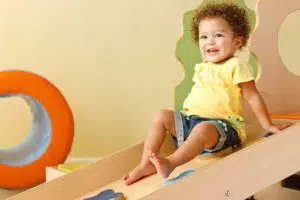They’re Called Schemas…
Written by Stephanie Gross, Director, Gymboree Play & Music St Albans
Jean Piaget’s Theory of Cognitive development states that there are four stages in which your little one will go through.
Sensorimotor (Birth – two years)
Preoperational (2-4 years)
Concrete (7-11 years)
Formal (11-15 years)
Focusing on the first two stages we note sub-stages called schemas. Schemas are repetitive movements that our little ones will practice and can often be described as children’s “fascinations”. There are many different types and sometimes the activities may seem a little strange or even irritating to adults, but to the child, it’s a necessary step in their understanding of the world and themselves.
Remember, each child is different, and some may display more than one schema while others show none at all.
Here is a little breakdown of each schema to help you identify your little ones needs:
Orientation
The urge to hang upside down. In order to ‘know’ what it is like to hang upside down or see things from a different point of view you must take yourself into those positions. Although you and I might not hang upside down very often these days, we still ‘know’ what it feels like to hang upside down – because we have the experience – we learned what it was to hang upside down when we too had our Orientation urge kick in.
Positioning
Do you find yourself Positioning things neatly into alignment on your desk, ordering the books on the self, getting creative when you plate the dinner or even just tidying-up. Perhaps you see your child lining up their cars, making sure the whale is next to the cow, or turning all the cups upside down?
The Positioning is a schema that is kept alive in us all.
Connection
Joining train tracks, clicking together pieces of Lego, running a string from one thing to another… the urge of Connection.
This can mean connecting and disconnecting too, building followed by destruction, and that can mean other people’s buildings and sandcastles get destructed when the urge gets hold.
Trajectory
The urge to throw and drop. Some other Trajectory actions are things like climbing up and jumping off (Trajectory of one’s own body), putting your hand under running water (interacting with things that are already moving) and the classic, throwing and dropping (making it happen). It can be diagonal, vertical or horizontal… this is a multi-dimensional urge!
Enclosure/Container
The urge to fill up cups with water, climb into cardboard boxes or kitchen draws, build fences for the animals or to put all the animals inside the circular train track, it is the Enclosure/Container schema.
Transporting can be the urge to carry many things on your hands at one time, in jars, in buckets and baskets, or even better containers with wheels.
Enveloping
To have a sheet over your head, wrapping things in fabrics or with tape and paper are all actions seen in the Enveloping schema. An extension of this is peek-a-boo, now you see it now you don’t, a concept that just keeps on amusing.
Rotation
Anything that goes around anything that is circular – wheels, turning lids, watching the washing machine on spin cycle, drawing circles, spinning around on the spot, being swung around. These are all experiences of the Rotation schema.
Transformation
The urge to Transform can come in many forms; holding all your food in your mouth for a long time to see what it turns into, mixing your juice with your fish pie, water with dirt, or helping Granny with mixing the bread dough.
It’s only natural that once you have explored and learnt about a raw material you should want to do further testing… there is a scientist and a chef in everyone.
Here at Gymboree Play & Music St Albans we see a lot of these schema’s in each class we offer. Come join in the fun today!




